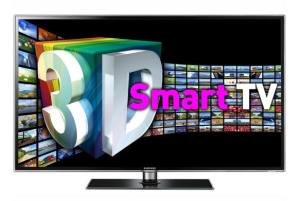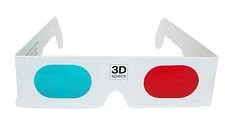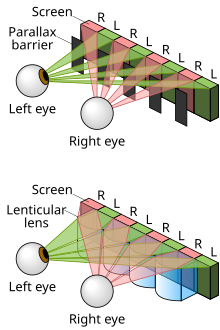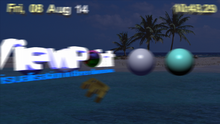Autostereoscopy is any method of displayingstereoscopic images (adding binocularperception of 3D depth) without the use of special headgear or glasses on the part of the viewer. Because headgear is not required, it is also called "glasses-free 3D" or "glassesless 3D". There are two broad approaches currently used to accommodate motion parallax and wider viewing angles: eye-tracking, and multiple views so that the display does not need to sense where the viewers' eyes are located.
Examples of autostereoscopic displays technology include lenticular lens, parallax barrier, volumetric display, holographic andlight field displays.
Technology
Many organizations have developed autostereoscopic 3D displays, ranging from experimental displays in university departments to commercial products, and using a range of different technologies. The method of creating autostereoscopic 3D using lenses was mainly developed in 1985 by Reinhard Boerner at the Heinrich Hertz Institute (HHI) in Berlin. The HHI was already presenting prototypes of single-viewer displays in the 1990s. Nowadays, this technology has been developed further mainly by European companies. One of the best-known 3D displays developed by HHI was the Free2C, a display with very high resolution and very good comfort achieved by an eye tracking system and a seamless mechanical adjustment of the lenses. Eye tracking has been used in a variety of systems in order to limit the number of displayed views to just two, or to enlarge the stereoscopic sweet spot. However, as this limits the display to a single viewer, it is not favored for consumer products.
Currently, most flat-panel displays employlenticular lenses or parallax barriers that redirect imagery to several viewing regions; however, this manipulation requires reduced image resolutions. When the viewer's head is in a certain position, a different image is seen with each eye, giving a convincing illusion of 3D. Such displays can have multiple viewing zones, thereby allowing multiple users to view the image at the same time, though they may also exhibit dead zones where only a non-stereoscopic or pseudoscopic image can be seen, if at all.
Parallax barrier
Comparison of parallax-barrier andlenticular autostereoscopic displays. Note: The figure is not to scale.
A parallax barrier is a device placed in front of an image source, such as a liquid crystal display, to allow it to show a stereoscopic image or multiscopic image without the need for the viewer to wear 3D glasses. The principle of the parallax barrier was independently invented by Auguste Berthier, who published first but produced no practical results, and by Frederic E. Ives, who made and exhibited the first known functional autostereoscopic image in 1901.About two years later, Ives began selling specimen images as novelties, the first known commercial use. Nearly a century later, Sharpdeveloped the electronic flat-panel application of this old technology to commercialization, briefly selling two laptops with the world's only 3D LCD screens. These displays are no longer available from Sharp but are still being manufactured and further developed from other companies. Similarly, Hitachi has released the first 3D mobile phone for the Japanese market under distribution by KDDI. In 2009, Fujifilm released theFinePix Real 3D W1 digital camera, which features a built-in autostereoscopic LCD display measuring 2.8" diagonal. Nintendohas also implemented this technology on its latest portable gaming console, the Nintendo 3DS. Micromax released the A115 Canvas 3D smartphone using an autostereoscopic cell-matrix parallax barrier 3D display.
Integral Photography and Lenticular Arrays
The principle of integral photography, which uses a two-dimensional (X-Y) array of many small lenses to capture a 3-D scene, was introduced by Gabriel Lippmann in 1908.Integral photography is capable of creating window-like autostereoscopic displays that reproduce objects and scenes life-size, with full parallax and perspective shift and even the depth cue of accommodation, but the full realization of this potential requires a very large number of very small high-quality optical systems and very high bandwidth. Only relatively crude photographic and video implementations have yet been produced.
One-dimensional arrays of cylindrical lenseswere patented by Walter Hess in 1912. By replacing the line and space pairs in a simple parallax barrier with tiny cylindrical lenses, Hess avoided the light loss that dimmed images viewed by transmitted light and that made prints on paper unacceptably dark.An additional benefit is that the position of the observer is less restricted, as the substitution of lenses is geometrically equivalent to narrowing the spaces in a line-and-space barrier.
Philips solved a significant problem with electronic displays in the mid-1990s by slanting the cylindrical lenses with respect to the underlying pixel grid.Based on this idea, Philips produced its WOWvx line until 2009, running up to 2160p (a resolution of 3840×2160 pixels) with 46 viewing angles.Lenny Lipton's company, StereoGraphics, produced displays based on the same idea, citing a much earlier patent for the slanted lenticulars. Magnetic3d and Zero Creative have also been involved.The hardware overlay for iPhone and iPod touch named3DeeSlide also adopts this technology to convert the standard screen into an auto 3D display.
Compressive Light Field Displays
With rapid advances in optical fabrication, digital processing power, and computational models for human perception, a new generation of display technology is emerging: compressive light field displays. These architectures explore the co-design of optical elements and compressive computation while taking particular characteristics of the human visual system into account. Compressive display designs include dual and multilayer devices that are driven by algorithms such as computed tomographyand Non-negative matrix factorization and non-negative tensor factorization.
Autostereoscopic content creation & conversion
This image is a fully working 1080 autostereoscopic 9-view image interleaved in the RealCel glasses-free monitor format, produced and instantly encoded by the ViewPoint-3D software. Use MS Paint to display it full screen on the RealCel 3D monitor.
Converting or creating digital content, including fully interactive content, for 3D autostereoscopic display is no longer a complex and expensive process due to the introduction in 2014 of instant conversion software tools that leverage the processing power of the modern GPU. Tools are now available not only to convert existing 2D and 3D movies to autostereoscopic formats, but also to create new and interactive content using fully WYSIWYG scene editors. In addition, a range of add-ons for software such as 3D Studio Max, Adobe AfterEffects and other software are available to enable the conversion of content to autostereoscopic formats.
In 2014, the problem of the real-time processing of the massive amounts of sub-pixel data needed to produce 3D autostereoscopic content and interactive presentations with live-data was solved by new algorithms developed by ViewPoint 3D, a London-based start-up.Tools for the instant conversion of existing 3D movies to autostereoscopic were demonstrated by Dolby and Stereolabs.
Direct autostereoscopic content generation
ViewPoint-3D and Taodyne are two companies offering direct autostereoscopic output using differing approaches. ViewPoint3D uses a WYSIWYG drag-and-drop 3D content creation editor that enables rapid creation of FHD and QHD (4K) 3D autostereocopic content, including fully interactive 3D content, that can instantly produce multiview 3D output with live-data from database and RSS feeds. Taodyne's Tao Presentation software allows 3D content to be displayed using a scripting language to describe dynamic documents in a way reminiscent of HTML for web pages, that can be etornal web-based editor.
The early days of 3D entertainment
When 3D films were first shown to cinema audiences, the viewer wore a special pair of blue-and-red-lensed glasses. Cinemagoers were actually seeing two different images being projected at the same time; but once filtered through the 3D goggles they gave the illusion of seeing a single, three-dimensional image.
We still wear 3D glasses at the cinema, but the way they work and how they look has changed. The 3D glasses cinemagoers wear these days use polarised lenses; lenses which let in varying degrees of light.

To see 3D these days, you don't actually need to wear special goggles - 'glasses-free' 3D delivers much sharper results. Instead of relying on glasses to filter the image, a completely different picture is shown to the viewer's left eye than the one projected to the right. As yet this approach to 3D imagery isn't used very often - it's expensive to produce, and would raise the price of 3D cinema tickets.
Despite its cost, this new 3D technology will undoubtedly take over eventually. Until now, if the viewer moved across the room then the 3D effect would begin to stutter. Now, the viewer can watch 3D images from any point in the room, making it much easier for families to watch 3D films together.
How 3D images work
There are several different ways to create a 3D image, but each method uses one of the following to create the illusion of seeing a three-dimensional object:
- Visual weaknesses (what the human eye can see, versus what is actually there),
- The way our brain interprets pictures and movements, and,
- The way we can perceive depth (the placement and location of objects in a scene)
Glasses-free 3D
3D cinema came back with a bang a few years ago, when a new 3D trend - prismatic screens - changed the face of 3D.
- A prismatic screen shows the viewer a three-dimensional image, without the need for 3D goggles. Take a look at these online examples created by amateur enthusiasts.
- Prismatic screens create an optical illusion for the viewer - similar to the way that a 'Magic Eye' picture does, but they can maintain the illusion for longer without exhausting the eyes.
- The word prismatic comes from the way that images are projected and then joined together again - the action mimics the shape of a Prism.
- The new wave of 3D-ready Smart TVs use prismatic screens to bring glasses-free 3D TV to an audience - at an affordable level.

Prismatic screens are covered with a special material known as a parallex barrier.
- This barrier does the same job as a pair of 3D goggles - it takes two different images and combines them, tricking the eye into 'seeing' a 3D object. Holographs work in the same way.
- The material covering the screen creates a layered effect - each of the viewer's eyes sees something different.
- Parallex barriers are a new technology, but they aren't perfect - they do have their downsides:
- The viewer has to remain in more or less the same spot - moving distorts the 3D effect.
- The brightness and colour definition is subdued as a result of the material covering it.
- They are only suitable for small-screened gadgets.
- The Nintendo 3DS uses a parallex layer to generate its glasses-free 3D image. The 3DS is the perfect gadget to make use of parallex lens technology; because the small-scale handheld screen and portable nature of the 3DS mean that the viewer can sit still while using it.
The latest development: 3D for fidgets
- The latest 3D invention uses lenses to create 3D images. It works by projecting a different image to each side of the viewing screen.
- The 3D image created using lenses is more flexible - it changes, depending on the angle it is seen from.
- The audience has more flexibility and freedom of movement -the viewer's location doesn't matter because there isn't an optimal viewing point (as there is with a parallex barrier).
- The screen's brightness isn't affected, but the lenses used are extremely difficult to produce. They involve high productions costs and specialist expertise to manufacture.
- The Toshiba Qosmio laptop is one of the few products currently on the market to use this cutting-edge technology. It can even convert 2D DVDs into 3D; a feature which hasn't been used commercially yet.

The future for 3D glasses
With glasses-free 3D gadgets already in the shops, what's the future for 3D specs? 3D technology is moving so fast - it's difficult to say when the very latest development will be as outdated as the red-and-blue glasses from 3D's early days. This article looks at the future for 3D eyewear, and explores when glasses-free 3D might become a staple of home entertainment.

Don't discard your 3D glasses just yet - 3D has some way to go before we all go glasses-free.
For the moment:
- Glasses-free 3D is only available on small-screened gadgets - handheld games consoles (theNintendo 3DS), and portable laptops (the Toshiba Qosmio range)
- With only one or two exceptions - glasses-free 3D hasn't made the move to our television screensyet
- Those which have made the move are the first generation of glasses-free 3D products. Just like 3D specs, they have their downsides
- The main problem with these cutting edge products is the slightly lower picture quality they offer (a special screen covering lowers image resolution). Another problem is that the viewer has to sit fairly still to maintain the 3D effect
- Because glasses-free 3D hasn't been perfected yet, the first generation of products has had tocompromise perfect picture-quality to achieve glasses-free comfort. The picture is still high-quality, but it has room for improvement
- Glasses-free products are getting better, but the technology is so cutting-edge that manufacturers are still catching up with the latest developments
- Because manufacturers are still getting a handle on the latest innovations, not all glasses-free 3D products are at the same stage. The products on the shelves aren't anywhere near as advanced as those under development
- The next generation of glasses-free gadgets isexpected to have better image quality, but we can't be certain when these will be ready for release. That's why, for the time being, 3D glasses are still in use
What we can expect to see over the next few years:
- Glasses-free 3D will eventually be rolled out to larger electronics
- We can't be sure when exactly, because the technology for this is so new that most upcoming products are still only at the design stage
- The second wave of glasses-free gadgets hasn't even hit the shops yet, and by the time it does 3D advancements will probably have surpassed these. Manufacturers can barely keep abreast of the latest improvements
- We'll see more and more glasses-free 3D products in the future, but at the momentmanufacturers are balancing problems with picture quality against reasonable production costs
- It may be that glasses-free 3D makes the move to cinema screens before it makes the transition to home theatres
If the technology is 'out there', why aren't we all watching glasses-free 3D?
- Glasses-free 3D is still very new, and it's difficult to harness it for the mass market at such an early stage
- As the industry gets to grip with the latest developments, more and more glasses-free products will be released
- The special screen used for the first generation of glasses-free 3D products relies on the viewer watching from a fairly static position (i.e. one where they stay fairly still). This works for small-screened gadgets where the viewer sits within 40" of the screen, but is less effective for larger devices (i.e. TVs)
- 3D glasses will; eventually become obsolete, but this won't happen for several years yet. At the moment, the reduced screen definition is standing in the way of glasses-free 3D from taking hold








Post a Comment